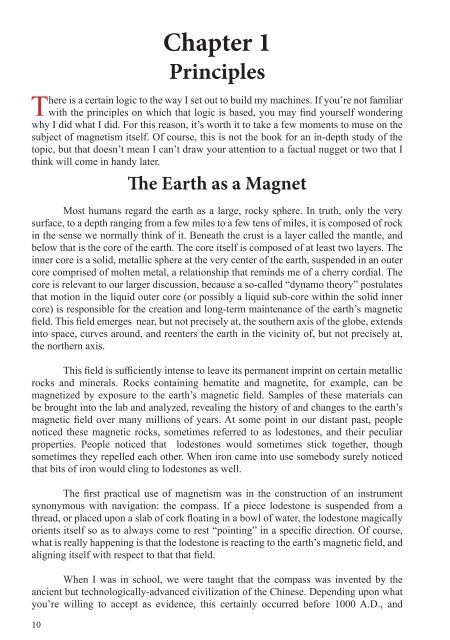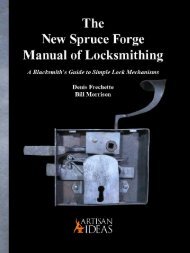Marvelous Magnetic Machines: Building Model Electric Motors from Scrap
You’re standing in front of an old card table in a driveway at a garage sale. On that table is a one-quart aluminum saucepan, a votive candle holder, pieces of some office machinery, and a wooden awards plaque. What do you see there? If you did not answer “a six-cylinder radial electromagnetic attraction motor,” then you need this book! H.P. Friedrichs (author of The Voice of the Crystal and Instruments of Amplification) returns this time to explore the principles behind the operation and construction of five simple, yet impressive, model electric motors. Aspiring mechanical model makers are often discouraged by their lack of access to machine tools, like mills, lathes, or drill presses. Friedrichs demonstrates that with some basic knowledge, an open eye, and a sharp mind, one can use commonly available (and often discarded) parts and materials to engineer one’s way around any lack of expensive machine tooling. In fact, every motor in this book was built from scrap, and can be assembled with hand tools. You’ll learn where to hunt for and find materials, and where to salvage suitable bearings. You’ll know where useful solenoids can be extracted from scrap, and how to fabricate bobbins to wind your own. You’ll learn how to time your motors, fashion a connecting rod, make a commutator from scratch, use a hall effect sensor to detect magnet position, use a transistor as a switch, and much more. Hardcover, 160 pages,177 photos and illustrations.
You’re standing in front of an old card table in a driveway at a garage sale. On that table is a one-quart aluminum saucepan, a votive candle holder, pieces of some office machinery, and a wooden awards plaque. What do you see there? If you did not answer “a six-cylinder radial electromagnetic attraction motor,” then you need this book!
H.P. Friedrichs (author of The Voice of the Crystal and Instruments of Amplification) returns this time to explore the principles behind the operation and construction of five simple, yet impressive, model electric motors.
Aspiring mechanical model makers are often discouraged by their lack of access to machine tools, like mills, lathes, or drill presses. Friedrichs demonstrates that with some basic knowledge, an open eye, and a sharp mind, one can use commonly available (and often discarded) parts and materials to engineer one’s way around any lack of expensive machine tooling. In fact, every motor in this book was built from scrap, and can be assembled with hand tools.
You’ll learn where to hunt for and find materials, and where to salvage suitable bearings. You’ll know where useful solenoids can be extracted from scrap, and how to fabricate bobbins to wind your own. You’ll learn how to time your motors, fashion a connecting rod, make a commutator from scratch, use a hall effect sensor to detect magnet position, use a transistor as a switch, and much more.
Hardcover, 160 pages,177 photos and illustrations.
You also want an ePaper? Increase the reach of your titles
YUMPU automatically turns print PDFs into web optimized ePapers that Google loves.
10<br />
Chapter 1<br />
Principles<br />
There is a certain logic to the way I set out to build my machines. If you’re not familiar<br />
with the principles on which that logic is based, you may find yourself wondering<br />
why I did what I did. For this reason, it’s worth it to take a few moments to muse on the<br />
subject of magnetism itself. Of course, this is not the book for an in-depth study of the<br />
topic, but that doesn’t mean I can’t draw your attention to a factual nugget or two that I<br />
think will come in handy later.<br />
The Earth as a Magnet<br />
Most humans regard the earth as a large, rocky sphere. In truth, only the very<br />
surface, to a depth ranging <strong>from</strong> a few miles to a few tens of miles, it is composed of rock<br />
in the sense we normally think of it. Beneath the crust is a layer called the mantle, and<br />
below that is the core of the earth. The core itself is composed of at least two layers. The<br />
inner core is a solid, metallic sphere at the very center of the earth, suspended in an outer<br />
core comprised of molten metal, a relationship that reminds me of a cherry cordial. The<br />
core is relevant to our larger discussion, because a so-called “dynamo theory” postulates<br />
that motion in the liquid outer core (or possibly a liquid sub-core within the solid inner<br />
core) is responsible for the creation and long-term maintenance of the earth’s magnetic<br />
field. This field emerges near, but not precisely at, the southern axis of the globe, extends<br />
into space, curves around, and reenters the earth in the vicinity of, but not precisely at,<br />
the northern axis.<br />
This field is sufficiently intense to leave its permanent imprint on certain metallic<br />
rocks and minerals. Rocks containing hematite and magnetite, for example, can be<br />
magnetized by exposure to the earth’s magnetic field. Samples of these materials can<br />
be brought into the lab and analyzed, revealing the history of and changes to the earth’s<br />
magnetic field over many millions of years. At some point in our distant past, people<br />
noticed these magnetic rocks, sometimes referred to as lodestones, and their peculiar<br />
properties. People noticed that lodestones would sometimes stick together, though<br />
sometimes they repelled each other. When iron came into use somebody surely noticed<br />
that bits of iron would cling to lodestones as well.<br />
The first practical use of magnetism was in the construction of an instrument<br />
synonymous with navigation: the compass. If a piece lodestone is suspended <strong>from</strong> a<br />
thread, or placed upon a slab of cork floating in a bowl of water, the lodestone magically<br />
orients itself so as to always come to rest “pointing” in a specific direction. Of course,<br />
what is really happening is that the lodestone is reacting to the earth’s magnetic field, and<br />
aligning itself with respect to that that field.<br />
When I was in school, we were taught that the compass was invented by the<br />
ancient but technologically-advanced civilization of the Chinese. Depending upon what<br />
you’re willing to accept as evidence, this certainly occurred before 1000 A.D., and










